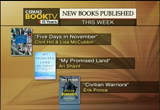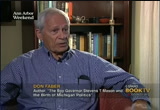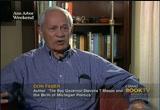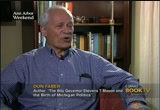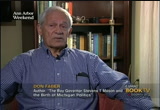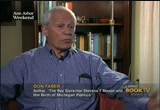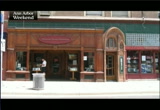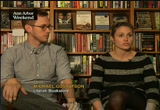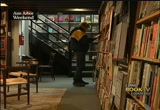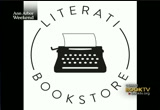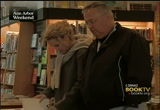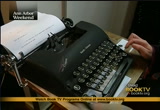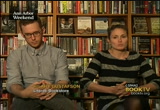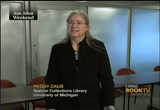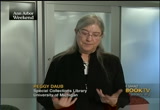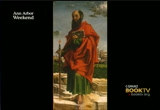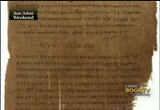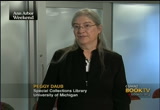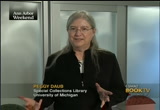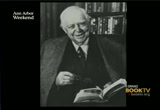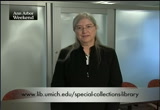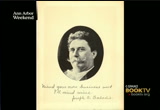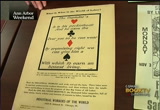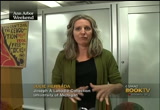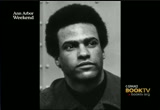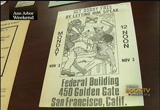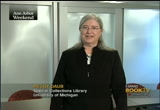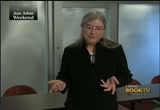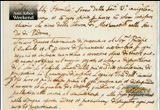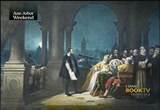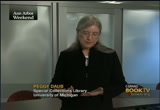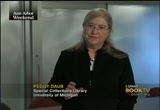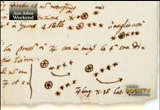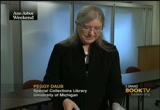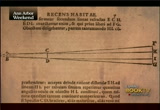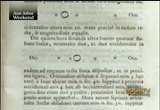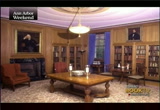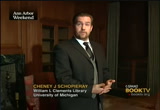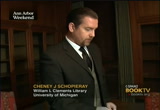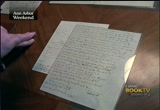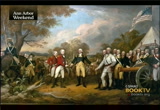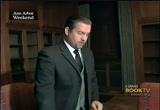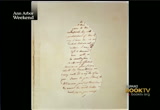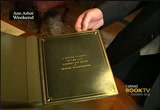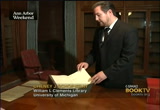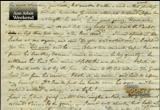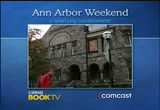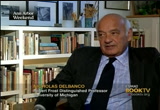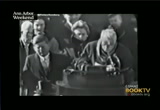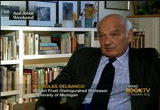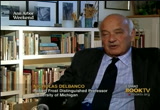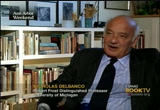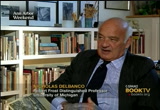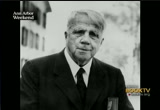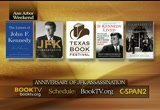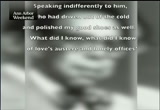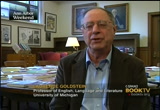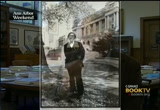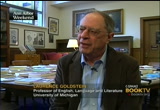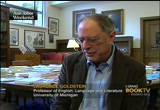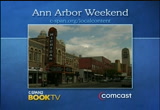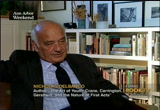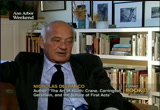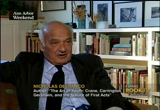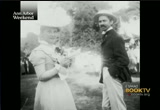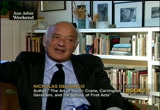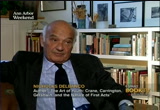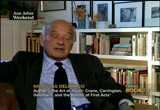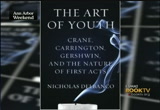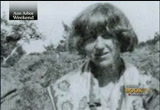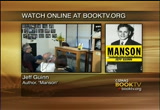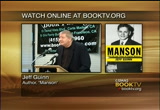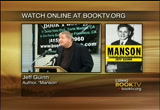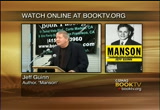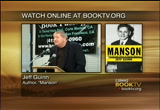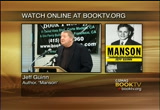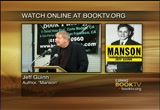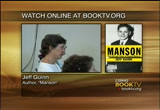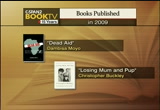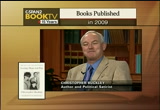tv In Depth CSPAN November 16, 2013 12:00pm-1:31pm EST
12:00 pm
"five days in november." in "my promised land: the triumph and tragedy of israel," ari shavit presents a history of israel. erik prince, the founder and former ceo of blackwater, a private security agency, argues much of the information reported about the company was false in "civilian warriors: the inside story of blackwater and the unsung heroes of the war on terror." look for these titles in bookstores this coming week and watch for the authors in the near future on booktv and booktv.org. ..
12:01 pm
we began our special look with local author don faber and learn about the youngest governor in michigan's history. ann arbor michigan. we visited the area with the help of our local cable partner comcast to bring you some of the city's rich literary culture and history. former ann arbor news editor said down with us to discuss his book a boy governor. the youngest chief executive in any state history. >> a very young age, appointed
12:02 pm
territorial secretary at 19 which is a record that will probably never be broken. another record was in 1835. and in time people in michigan and the people of detroit came to trust them even though a young person, very skilled and dedicated leader. regarded first of all as by the people in his own territory as a bit of -- coming in from kentucky. the logical thing for him to do would have been to appoint a michigan person. because mason had made such an impression on jackson himself,
12:03 pm
they had met. jackson of this cement has a lot of confidence and vision. i will appoint him. the strip of land that was disputed between michigan and ohio at st. their back to the northwest the soon to be state michigan would be a straight line. no one knew for sure where the southern end of lake michigan is when ohio became a state they slipped into their constitution a provision calling for of a slightly angled line, the northern boundary so that it would include the future port of toledo which was going to be the northern terminus of a series of
12:04 pm
canals that elmira was building. all of its investors were ohio people. the governor of ohio had to protect its investment. they made sure that the northern boundary concluded toledo. after two surveys were taken, one by michigan and won by ohio, the one by michigan determine that toledo was in michigan. the one that was in ohio determined it was in a while. things settle down and missing people moved into a strip of contested land, organized into townships, collected taxes. then in 1835 things all came to a head when governor lucas said i'm going to protect that land. governor mason said, i'm going to protect that land. in the organized the ohio militia and the territorial militia and actually got into a shooting war over 470 square miles of basically swamp and
12:05 pm
farmland that machine claimed legally it around. the war then proceeded in a series of skirmishes the route 1835. no one was killed. it ended up being brokered by congress in 1836. as compensation we will give you the entire western two-thirds of the upper peninsula of michigan. that is some michigan ended up with the upper peninsula. and it was not until 1837 finally that michigan was officially welcomed as a state. when mason was elected governor he had already participated in helping tow right michigan's first constitution. that constitution called for a
12:06 pm
superintendent of public instruction to oversee the schools. this had never been done in any state in it union up to that time. prohibition in slavery which was pretty progressive at that time, considering that the civil war was still roughly 30 years down the road. mason was so far ahead of his time to meet call for an appropriation to build this to locks. for that he got laughed at by no less a statesman and henry clay, the great in the clay of kentucky said, in effect among why don't we just build something in the face of the moon. all those many years later when michigan in detroit became known as the arsenal of democracy michigan had mason to thank for that vision of building those locks which could then get those ships bringing all that iron ore and minerals down to the
12:07 pm
downstate steel mills where they could make the plans and the tanks and everything else to help defeat germany in world war two. we had mason to thank for that. the unfortunate thing is his timing because as san as mason became governor the national financial panic of 1837 hit, in michigan was one of its chief victims. because mason had outlined all of these expensive plans for development, hoping that he could find it with good money, but then the banks failed, in part because of president jackson's policies, in part because of economic conditions at that time. in so mason was left : the bank. and he soon developed quite a coherent set of enemy's who attacked him for bringing
12:08 pm
michigan. when mason ran for reelection he just barely won, and by that time his opponents and the whigs were really on his case and accused him of being a demagogue and taking the state. that in effect roy and mason in the eyes of michigan people who in their shortsightedness forgot all the things that mason had done prior to that which was setting into place all of our institutions, the educational institutions. the democrats' stated, that sort of thing. they forgot. mason eventually had to leave michigan in virtual disgrace. now, mason was elegant. he had a wonderful viejo kentucky demeanor about him which, at first, may have set him off to michigan frontiers and as some kind of very lofty
12:09 pm
individual, but he understood michigan politics and how it worked. he became a man of the people. they left him so much that by the time he had died already at age 31, by the time they brought him back to end of year several by so that mason was regarded as a great statesman and a person who has said michigan off on the right path by from the start. >> on our recent visit to ann arbor, mich., book tv stopped in to talk with honors hillary in mike christensen on book selling in the digital age. >> and independent bookstore selling new titles. we focus on literary fiction and
12:10 pm
social sciences, poetry. just means educate people are interested in books. i worked for simon and schuster for about five years. my job was to pick out the titles that i thought were appropriate for independent bookstores. >> hillary introduced people to bookstores and books to me. when we were living in brooklyn we visited bookstores. and we saw how they were successful. they were just part of the livelihood. >> always have conversations a lot will -- about what makes bookstore's work. kind of washed with what was happening, watch that evolving. when the other independent bookstore in march and closed
12:11 pm
and borders announced they were closing, we were like, how is there no downtown bookstore selling new titles? a college town, a huge, you know, literary culture your. so what if we did that. what if we -- >> hillary grew up in and robert. she grew up on the north side. she grew up going the bookstores here. i have family here. we always wanted to move back to michigan and to ann arbor and start a bookstore. >> ago is always scary because that was the time the borders was closing. bookstores said, some much was changing within the publishing landscape. but from what i could see from the bookstores and i visited, a round of local shops. but the curator inventory. in nine think that also ties in to the local movement that's
12:12 pm
been happening for a few years. all of our book shows up from borders. number one is what they called it because it was the one based here in ann arbor where border started. and we bought the shelves actually before we even signed the lease here. reelect, we are going to open a bookstore. we don't know where, but it will happen. we really wanted the shows from borders. and so we bought them and store them until we were ready to move in here. it is really, really great. i mean, have part of borders be part of who we are because it is part of an arbor. >> people that come in and say, i've seen the book shows before. they say in an emotional way because they had a solid connection. we're just really lucky to have these in the store as sort of a piece of ann arbor that we can keep going. >> and i think providing a space
12:13 pm
where people can meet and discuss ideas in an open setting and bring people together that otherwise would not come together is the importance of a brick and mortar store where customers will come in and buy a book and say, i'm buying this because i don't you close. they have seen borders closed,. >> they shop at our store because they want to see a bookstore be part of their downtown. >> so much emphasis these days a algorithms providing people with -- companies using algorithms to provide customers with what they think they want. and it loses some of the whimsical nature when you rely on those of rhythms. i think a bookstore can offer those types of surprise is. >> some independent bookstores to sell the-books. we just chose -- chose not to because we want to focus on the printed book and the written word.
12:14 pm
the community center instead of just a store that sells a product. and i think that is what differentiates us from the online retailers or e-books in general. they each have a place within the market. print books and the-books. and i think there always will be a place for both. >> and reading books is an individual process, a solitary process, and isolated process, but it is also a collaborative process. that is why book clubs are so successful, and writing groups are so successful. >> in bookstores because we see people come here all the time, strangers will be looking at a book. some will say, oh, that booking year and is a great book. you should read that. it is really fun to see those people who otherwise would not be chatting with each other kind of come together around an idea for an offer for a kind of
12:15 pm
writing. >> other customers will come in and say, i have digital burnout. i steered a computer all day long. the last thing a lot to do before i give asleep is look at a tablet or look another screen. i just want a soft feel of a paper book purchase to my local independent bookstore. there is a throw, i think, about having something that exists in a world that cannot be deleted, changed. it is is there. and we have tried to embrace that with our typewriter logo and offering out a public typewriter for people to type on. whenever they want. some people come and tight really positive messages or quotes were just general salutations. other people, and on a saturday night in type really dark stuff. that is the point of allowing someone to come in and take something that is not going to go into the black hole of twitter with internet.
12:16 pm
>> sort of the reason we chose a typewriter is a love of the media, with the typewriter. on the page. there is no the lead. yet to be really tough follow what's your riding which is the kind of writing that we want to support, very thoughtful, engaged wedding that you don't find all the time. i think the future of bookselling is independent bookstores. they really are the place where, you know, incubators of ideas and places where riders can practice their craft as well because the book sellers, independent bookstores are reading some much and injecting with writers and providing space for new ideas to come across. i think that really is of feature -- the teacher a bookselling.
12:17 pm
>> on our recent visit to an art, mich., book tv talked to librarian and curator peggy dollops who recounted the creation of the power books and showed us letters dating from 280. >> and michigan, papyrus manuscripts of the letters of st. paul it be from paul the apostle, not by man, by jesus christ and got a father who raced in from the dead and all of the brothers with me to the assemblies at galicia. greetings to you and peace from god the father and our lord jesus christ and gave himself for his sins in order to save us from the present legal age according to the role of god, our father, to him to uribe for ever and ever. this manuscript is famous because it is the earliest known copy of this part of the bottle. now, there are many interesting things about this. will start with the fact that it
12:18 pm
was produced as well we think of as a book form, codex form rather than a piraeus scroll. these would have been next to each other and share that. by the way that the damage is needed by these two pages were part of the same book form. and they were written on papyrus . made from the papyrus plant that grows along the banks of the nile. in so what you find is come from egypt, not all, because the did exports to other parts of the ancient world as well. and so created as a book. we originally believe that it had 104 leaves. the university of michigan holds 30 of these, which in dublin, ireland holds 56 of the lease. eighty-six of the 104 still
12:19 pm
exist. the reason that they can estimate how many leaves there were to begin with is because each leaf has the pace never at the top. and these were created by just taking leaves of papyrus and folding them together. would be like having a stack of 52 pieces of papyrus in folding them in treating a book of that. and so because i know, some of the leaves are actually still attached to each other. and so they know the numbering of one in one part of the book and one in the other part of the book. from that they could estimate how far from the beginning the first will was. they knew how far from the and the bottom almost. 1846 contained most of paul's letters to the early churches. so part of the need to estimate that is documentary in a way because it is not telling the story of jesus' life, but it is
12:20 pm
factual correspondence from paul to these early churches. is the earliest known copy. there is no sensational new book of the bible there, like the dead sea scrolls, for instance. and so it is actually interesting that the text was pretty stable. the text we find in this copy, the oldest known, still pretty much coming down to us today. a few rearrangement of things, but it is not sensationalistic, which really speaks to the care with which it was copied and the stability that the text had for all of those hundreds and hundreds of years. the papyrus is written in greek. and unlike modern greek, ancient greek was written with no spaces between words. no distinction between capital and lowercase letters. we don't know the exact date because it is not dated.
12:21 pm
we do have things like tax rolls or case reports, and they carefully have dates written on them, but this is not. war in the category of literature. so the way they tried to guess what date it is probably from is from the nature of the object itself and especially from its handwriting. based upon its handwriting, and guess can be made of the time that it came from. the guesses boat somewhere between 180 adn 2150d. so it is not from the lifetime of paul itself, but it is as close as we can get to paul's life time and a copy of the letters he wrote. this was not found as a result of archaeological digs. we don't know who actually found it. it came on the market. so it is affected by the fact that it has no context in
12:22 pm
archaeology. we don't know what layer of strata it came from, what other objects or books might have been near it that would help the state in place it into that historical context. unfortunately it was found by someone who was not a scholar or interested in preserving that kind of skull of the evidence. it is really interesting. it was sold in pieces over years. and even believes that we have, we got some of them by 1931 and in the rest of them two years later. the library collected some over years until they finally at 56. i think by then people kept thinking, well, the whole codex is eventually going to be bound, but it never was. so another interesting thing, and this is much more to do with the production and mild correction, the scribe who wrote
12:23 pm
it was professional. when they came to the end of the book commute they are finishing up one buchan beginning to do a book in hebrew, they wrote here how many lines their britain in the previous book. that had to do with how much the material might be sold for or how much they might be paid for rather than the text itself. and they do it here. this is another example where you come to the end and you are starting galatians. again, there is a little side note under the text that gives the number of lines it is very interesting. it was clearly a battle. there really went to collect important pyorrhea the time. these leaves were first being published there were three publications and wrote. a first one was michigan
12:24 pm
publishing the ten leaves the end of the time. and then we have some. and so another edition of published with the leaves them at the time. and then a third edition was published with michigan saying, oh, we have more leaves, 30 now. and so that was published again commit each of the income is being included. it was after that that chester said, well, we have 20 more. so there seems to be some kind of competition between the two. but it is actually very nice because now some of the leaves on this side, some on the other. people can see them those. of course, people can see them. the papyrus or one of the first parts of the library collection to be digitized. they are readily available. >> as part of book tv visit to ann arbor, mich., we stopped at the university of michigan to learn about the university's joseph a live body collection,
12:25 pm
the oldest research collection of radical history in the country. curator julie brown and show us around. >> a labor organizer and an anarchist from michigan, born in 1850. he got involved in anarchism by reading a newspaper called liberty which was published a boston my name to of a man named benjamin tucker. very influential newspaper at that time in the 1870's and 80's. he wrote a letter to the publisher asking and talking about his ideals on anarchism and what that meant to him. the letter was published in the newspaper. they became lifelong friends after that. his views on energy or that more like individualism, you mind your business. nobody would be coerced into doing anything as long as in not having anything else. a unique collection that represents a radical and special protest history of the united states.
12:26 pm
an international collection. so we don't stop at any boards for collecting. we collect materials going back from the 19th century until the present. and it is heavily used in a very popular thing in growing all the time. so i have up portrait of jussive taken in detroit when he was around 30 years old. this is a sample of one of his book was that he bound himself. he did his own selling in binary and the solyndra machine that he created. he did his own printing in his own shop. this is a sample of one of the pamphlets, many of the templates to me were bound with scraps of paper that he had lain around because it could not afford to give binding for them. so here i have some sheet music from the various time periods. this is the international which is a very famous radicals on that is known throughout the world and published in many,
12:27 pm
many languages. this is one of the additions of that she music. and we have different -- many different kinds of sheet music. so this is an earlier one about unions. much of our earlier collections are about live reunions. so he was not a member of the iww. the very first curator of the collection was a member. she became the first curator in the early 1920's. because of her work we have one of the best collections of literature in the world. we have this poster which i really like a lot. he uses the club so that he can wear diamonds. by organizing right we can give him a which to earn an honest living. we have his ashes.
12:28 pm
this is actually the envelope that is ashes were distributed in to all the different union locals around the world. his body was cremated and the ashes split up. a letter came around with this envelope with ashes saying to many local can distribute these ashes, but please write us and tell us what we do with them so you have a record of a. we have an interesting collection. and it was a court case of sidney street, convicted of desecration of the flag in 1966. when james meredith agone to mississippi to actively participate in this civil rights struggle, he was murdered. sidney street was very, very upset by this. in new york city he got word that this happened. everyone knew about it. a big protests, demonstrations all over the place. he burned a flag in protest saying that if that could happen to james meredith, we don't need a fine in this country.
12:29 pm
so he was arrested and convicted of desecration of the flag. eventually the case when all the way up to the supreme court, and it fell on his side and as a first amendment case in his favor. soviet freedom of speech. so part of the collection includes the french flag, remnants of the burn flags that were used as evidence against him in the case. and you can see that this is a court document behind him. this is a protesting nixon and the vietnam war. and was held at the university of california at berkeley. in this system a demonstration to protest the racist and fascist attitude of tricky dick nixon and also handwritten on the sides, free huey, huey newton was the head of the black panther party at that time it was in prison. and free bobby, bobby seale, the minister of defence for the
12:30 pm
black panther party. bobby was arrested several times for various things. one of the things that he was famous for was the chicago eight trial. during the democratic national convention in chicago in 1968 it was a massive protest. eight people who were leaders of different organizations at the time were rounded up and convicted or put on trial for conspiracy to overthrow the government. bobby was one of those people. in one of my favorite things is this fire here set him free by letting him speak because he tried to act as his own attorney during the trial. the judge would not allow him to act as his own attorney. so he kept trying to speak and is on behalf, refusing legal help. they actually eventually bound and gagged him in the court to a chair. tied his hands in the taped his mouth, and he had to sit there.
12:31 pm
yeah, it was an incredible scene of oppression and racism in that courtroom. so eventually he was separated from that trial and had his own trial eventually, but he was part of the original eight. we have quite a bit of material on the occupy movement. this is called occupy media. this is the organization that publishes these. a free association, reflection of the rebellion from the occupied media. so these are brand new that we just received a couple of weeks ago. and then you have this one, this one is taking the brooklyn bridge. stewart leonard. this is a publication in english and spanish. there is never going to be an end to social protest, so there's never going to be an end to the amount of materials and coming in and being preserved. and being made in accessible to the world for free. that is what i want people to
12:32 pm
know. we are preserving this for everybody to use. it is free, and it is open to the public. >> the university of michigan in ann arbor is on to the galileo manuscript, a single leaf document which consists of a letter and notes on the minds of jupiter written by galileo in the early 17th century. book tv learned that the manuscript on a recent visit to the university. >> welcome here to the special collections library at the university of michigan library and to show you some of the incredibly special things that we have. the first thing i'll be talking about is a manuscript by galileo l.a., a very noble scientist, often credited with inventing the telescope. he did not really invented. but he took was he took the telescope and greatly improved it. so he could see things that no one else could see. what i am going to show you first is the manuscript at the
12:33 pm
university of michigan ounce. this manuscript is just one page, written only on one side, and it is basically a piece of scratch paper. but to me that really is its glory because it was not something that he carefully thought out. it was not his finished product. it is really where you can see his mind work. the manuscript is self is divided by a line in the center. that line represents the times sees this piece of paper. the first half, the top half of the piece of paper he used in the summer of '69. apparently he had heard that there was a man from the netherlands who was trying to sell a telescope to the decision where he lived. an instrument maker himself, he can certainly build one, and so he did. he sat down and build one. he did in one night. may have taken a little longer than that, but he did build a
12:34 pm
telescope that and large things at least three times. then he got better and better and started making them. within a few months he was making them among those tips that could magnify probably 20 to 30 times. but this was back in august. after they had that first telescope, a man who wrote the great entrepreneur, he wrote to the decision to suggest that he could share this for a price, of course. this piece of paper is where he wrote down his first ideas for that letter. it is his draft idea. and it starts out with very flowery language. and your great servant and so on. and then he describes that he has made this spyglass as he calls it that can be very useful for business and for military applications. and with this you could see the enemy and see, for instance.
12:35 pm
you can see the sales of their ships two hours before you could without using the telescope which would give one a great military advantage. and so after seeing one you could decide if there were too many to fight and go away before they knew you were there or you could stay engaged in battle. one thing he says that he puts down as an idea in this draft is that he would keep it a great secret. that changed, and in the final letter which still exists and is in a library in venice he says he will do a public viewing of the telescope which is what happened. he had people come in august of '69 and climb to the top and look through his telescope there. and so this is some of the nobleman in the court. it was open to them, and there were all very impressed. so he did, not just money, but
12:36 pm
granted a position for life at the university. so that was the summer of '69. one of my favorite things up this manuscript it really shows is that go there was human was that this piece of paper apparently just laid around his house for a few months, and then he pulled it out and use it again. so when he pulled it out again, it was january of 1610. and what he used it for then was a very different purpose alpha. he used this piece of paper to draw together something that was puzzling and. what was puzzling him were some bright objects that he saw around the planet jupiter. a visible only through the telescope, no one else had seen them before. and he did not understand why they were moving in a way that they were. in the manuscript he chose on the seventh of january, they
12:37 pm
looked like this. and he shows that it was three things. i think that state line, the next night when he came across jupiter and saw these things on the aid in january that looked very different he could remember even without consulting his notes that they were in quite a different configuration and they have been the day before. now, at that point he did not know what they were, if there were background stars which would be the logical conclusion. they should not have been moving that fast. sari did not know if it was something else entirely, if he made a mistake. he did not even know if he was seeing the same thing each night. but he decided to keep track of that little piece of the sky. you watch jupiter every night for a week. here he get it together what happened during that week from the seventh of january through the 15th. he goes through the days of the week.
12:38 pm
he says it was cloudy. here is the 15th. now, after that we go observations this is what marks galileo as a truly modern scientist. this is the difference between theoretical science to observational science of the modern time. what he did was to try to make sense of the data. he had data and was trying to use it. in this corner of the manuscript that scientist, galileo was trying to imagine what these subjects will look like if instead of looking and jupiter, as we must do, if he was looking down on jupiter. and it was when he took that leap of intellect to try to figure data into completely different way of looking at things he realized the optics are going around jupiter. this was huge news.
12:39 pm
it sounds like the night of january 151610. he switched from riding in italian which is what all of this is to riding in latin. the reason was not for secrecy, but for publishing. at that time the scientific text were published in latin. he wanted to make sure that he let of the scientists know about this and wanted to make sure that he was the first to be did not really know who else might be up there with the telescope and observations. so he switched from riding in latin right away. within two months to published this small pamphlet, not logic of, one of the most important books that has ever been published. as many people of said, it just
12:40 pm
demonstrates made discoveries that gilliam made that very important to us. dedicated to the due to been e.g., he calls the four story of jazz that he saw around jupiter and named them after the dew to mytishchi. the date of the dedication is here. it is the fourth of march, 1610. being in italy, one important thing that had to happen was that it had to be passed by the censors. this is a page this just shows that this was passed by the censors on the first of march march 1610. one of the first things that galileo had to do in this the book is to explain how he was seeing these things a very important finding that shown here, the futures of the moon
12:41 pm
which no one else had seen. the page here, starts out a paragraph saying, the last seventh of january is really restores discussing what he saw around jupiter. he starts with a diagram of what he saw on the seventh, the things making the straight line across jupiter. you will notice that instead of being identified -- dagen of their inner manuscript. eastern did not to make it much easier to publish. and then on the eight, unlike the manuscript, the book goes on after that first. goes on for all of the rest of january. and for all of february showing each night when the subject or around jupiter. by then his argument could really be conclusive that these subjects were not background stars.
12:42 pm
and this really changed the way we see our universe. that is why this manuscript which is the topic of his thinking is so important. >> book tv took a trip to ann arbor michigan to explore the literary set to the city with the help of our local cable partner comcast. during our visit we met a curator of manuscripts at the university of michigan's william help on the fly very his best early accounts of the american. >> at the university of michigan , a special collections repository cares for, collection, and preserves primary source materials related to the history of early american today we are talking about a few of the manuscript is, bucks from the original donation, again,
12:43 pm
1923, to represent the book division of the library selected this rather unassuming volume written in latin and printed in 1493 and rome. it is a printed version of columbus's letter to the king and queen in which he describes his discovery of the new world. this is the first printed account of what later becomes the americas, the cornerstone of any collection of early americana, roughly 17 editions were printed before 1500. this edition is 1493. so these cornerstone collections of the manuscript division, an unparalleled book, the british administration of the american
12:44 pm
military ventures. and the dissertation, the original research done on the british side of the american revolution must make use of these materials. they are extensive and provide the most direct sort of resources on the conflict from the british perspective. here is a manuscript written in the hand of thomas gage in april april 18, 1775 in which he gives orders to lieutenant-colonel francis smith to pull together a group. west of the city of boston. march with a core of grenadiers and light infantry with the utmost expedition and secrecy to
12:45 pm
concord where you will seize and destroy all of the artillery and ammunition provisions, tense, and all other military stores that you can find. in effect, this is the draft of the order that begins the american revolution. also acquiring the papers of stanley clinton, approaches the 1925. one of the interesting components of his papers, a lengthy set of correspondence and documents pertaining to benedict arnold and his treasonous correspondence with the british headquarters. a letter written in code by benedick donald to my dictionary substitution code, groups of three. these numbers just grab the page number.
12:46 pm
and once this particular manuscript, benedict arnolds conditions for the active turnover the important post of west point. a contemporary translation of the coded documents. we will read a passage from that if i . out a plan of cooperation by which certain ratio possessed himself of west point the garrison, 20,000 pounds sterling , i think, will be achieved purchase for an object of some much importance. another example of an item from in the clintons' papers is written during the expedition in 1777. a number of items in clintons' papers are written in code,
12:47 pm
12:48 pm
forming gone from hands. the rebels imagine that he is don once the mask is placed over the manuscript, reiterate a similar sentiment but provide and the clintons thoughts on the matter. gone to chesapeake bay, the greatest part of the army. landed. left to command here with too small a forced to make any effectual diversion in your favor.
12:49 pm
try something at any rate. but think just that this time. he could have taken. also this letter written by charles cornwallis in october of 1781 in which he is in forming his commander in chief of his surrender at yorktown, virginia. the letter announcing essentially the conclusion of the american revolution. i have a modification to a form your excellency that i have been forced to give up the posts of york in the rochester and to surrender the troops under my command by capitulation on the 19th as prisoners of war to the combined forces of america and france. the next manuscript i would like to show is a manuscript written by tobias lear, washington's personal secretary describing
12:50 pm
the generals last hours at mount vernon in virginia. this is tobias. he is providing this particular accounts. washington's sickness and death. in it he describes george washington efforts for cutting at mount vernon. the estate. bringing home the cough and subsequent decline in health and unexpected death in december of 1799. being at the house committee describes the comings and goings of the doctors of the family, describes washington's mood and statements, rather extensive description.
12:51 pm
the description, if i make. the statement regarding washington's death in december 14 to 1799. he writes, about 10:00 he made several attempts to speak to me before he could effect it. at length he said, i am just going. have me decently buried and do not let my body be put into the vault and less than two days after i'm dead. he lifted me again and said, do you understand me? i replied yes sir. about ten minutes before he a spired, his breathing became much easier. he felt his own pulse. he spoke to dr. craig to set by
12:52 pm
the fire. he came to the bedside. the generals and fell from his rest. dr. greg put his hand over his eyes and expired without a struggle or a side. the library is a premier repository for the study of early american history, currently stretching to about 1900. the library is open to scholars and to the public. we always encourage researchers to come and utilize the materials. >> the robert frost distinguished university of michigan in ann arbor. during book tv visit to the university, he spoke with us about the lives and work of robert frost and the time from spent in an arbor.
12:53 pm
>> i'm sorry i could not travel. long i stood, looked down as far as i could. then -- >> robert frost is perhaps the preeminent, one of the most consequential of our american poets of the 20th-century. he was principally known as a newfoundlander because that is where he principal lived. that is where he is buried, new hampshire. importantly also. he was a poet who probably set the national standard for what it meant to deal in the plane american-style. polaroid's new him first as an
12:54 pm
important practitioner. he had a lot of trouble early on we can talk about that. by the end of his life command is death he was very close to the national spokesperson. almost everybody alive in america saw him at john f. kennedy's inaugural in 1961 when he stood of at the podium and famously read or recited the gift of life. >> about the new order of the ages. >> at that time he was unquestionably the most important american poet. contender. t.s. eliot who move right away.
12:55 pm
spend his life, is largely life in england. so the quintessential american figure and he represents in a certain sense what emily dickinson did a century before the private lender breaking new ground. >> always engaged in the formalities. he was quite rigorous about them . and as if the language were not something that came to you from an olympian height and required a dictionary, frost was of planes spoken persian about the life and his art. he was celebrated almost entirely as a new england poet. he spent some time in florida.
12:56 pm
but the vast majority of his life was in vermont and new hampshire, massachusetts also. nonetheless, some one and an arbor. in 1921 he was invited to be a kind of writer in residence. now you can throw a stone at the university without uncovering a writer, an artist in residence, but at that time which is after row a century ago, it was revolutionary notion, kept a very stiff arm and remove from academia. you know permafrost was not a scholar or a university graduate
12:57 pm
himself. he ended up receiving all sorts of lottery degrees and became often a doctor of letters, but at the time he was somebody you was more known as a farmer and a private citizen. for university to invite him to say you're a person of consequence, what you hang around was already rather remarkable. he came and stayed for a year. he returned again for couple of years. so his tenure here was relatively brief. it was nonetheless an important time of his creative life. some of the palms we think of as about new england were composed here, perhaps of a sense of sorrow. perhaps out of a sense of nostalgia, but nonetheless, the
12:58 pm
hardest hit to hold. subsides. so don goes down today. nothing gold can state. his work became more and more consequential during the course of his life. he was considered by many to be a sort of folksy poet and a local spokesperson and hero. one of the types to said nice things about fences and birch trees. one of his early biographers, it was not that hard to do, some of the less splendid aspects of his
12:59 pm
personal and public life. and at a certain point people began to confuse or conflate the difficulties that he had, the madness with a light hearted ceiling surface. and it took a bit of a nosedive. i think by now that has reversed again. he is understood to be a poet of great depth and complexity. without overstating the case for an arbor or making it crucial to make is important to remember a may seems so rooted in a particular place. also a elsewhere. and the fact that his work,
1:00 pm
1:01 pm
1:02 pm
>> one of the major poets of our time, a fascinating figure because he represents the world of early detroit, detroit in the teens and twenties in the 20th century and all the way through the depression, the war, the aftermath of the war. and there are so many areas in which he has written beautifully and in compellingly. >> what is it about his work that makes him so intriguing? >> i think one of the attractive features is that all of his palms are written in different voices, different forms of techniques. very deliberate about this. although his work is only 200
1:03 pm
1:04 pm
>> members of what was then called the black arts movement were resentful of him because he did not write political protest poetry, at least he did not protest as angrily as they wanted him to do. so he felt like he was on the margins of the literary scene, and he resented this, because he could see the poets who were objectively speaking not as interesting as he was were getting awards, they were getting appointments at major universities. and he was being neglected. but all of that changed, i think in the 'of -- '60s there was a lot more attention paid to him because he had written these ground breaking works about african-american history. >> there's freedom, there's liberty, this beautiful and terrible thing, usable as earth. it belongs at last to all.
1:05 pm
>> there came that time when he was appointed the consultant in poetry at the library of congress, and that is the position now called the poet laureate. so he was flighted. i mean -- delighted. i mean, that was major recognition. he was the first african-american to hold that post, and so he got a lot of attention. everything started to come together. his collected poems came out, he began to get major reviews. i remember the review that julius lester wrote in the "new york times." the day after that appeared, i think maybe that was the happiest i've ever seen robert in my life. and so those last ten years, the ten years i knew him, were a happy time. nevertheless, he had these, as he called them, personal demons that kept especially memories of the past, memories of his days in detroit as a child and so forth that kept coming back to him. he kept returning to in his
1:06 pm
work. >> was his poetry more based on a nonfiction, life-lived sort of poetriesome. >> some of it was, yes. personal poetry which, of course, is exactly what we mean when we talk about lyric poetry in the first place, that the speaker has some interesting relation to the author. the author is free to headache up materials -- make up materials, but also tends to stick to some of the basic facts of his own life. and hayden had a difficult upbringing. he was a child who had very poor eye sight, and so he never participated in games. he was picked upon. his interest in poetry, which developed at that time, of course, made him an object of fun among many of the people who knew him who didn't take poetry seriously. and i think that hayden had a melodramatic life, a life that
1:07 pm
started in the ghetto, in which there was sort of a lot of fighting in his house, in this his neighborhood -- in his neighborhood, a lot of violence. he was especially sensitive to violence which, of course, made him a very interesting commentator on african-american history. he wrote poems like "middle passage." >> eight bells, i cannot sleep, for i am sick with fear. writing eases fear a little since still my eyes can see these words take shape upon the page. and so i write as one would turn to exorcism. now the sea is calm again. >> lastly, what is the -- what do you want people to take from this interview? >> well, i would like to think that my colleagues and friends would read hayden with more sense of how connected he is to the major writers of our time. i think that's often how it
1:08 pm
works in literary history, that a person will come -- a writer will seem hard to classify, hard to categorize and so not as much attention will be paid to them. gradually, though, everything becomes configured, reconfigured, and we see that that person was a central intelligence of his time. and what he was doing, what he was writing really reflects the zeitgeist spirit of the age and that he deserves more careful study and more attention. >> during our visit to ann arbor be, michigan, booktv visited with professor nicholas delbanco who talked to us about his book, "the art of youth." >> my new work of nonfiction is called the art of youth: crane,
1:09 pm
carrington, gershwin and the final acts." the first and final chapters are general considerations about, you know, the multitude who do die young and the risks, as i said, attendant on early success. the enemies of promise, if you will. in a certain sense, this book is a prequel to a book that i published a couple of years ago called "lastingness: the art of old age." in that book i considered the career trajectories in a sense of painters, writers and musicians who at least maintained, and in some cases advanced their art past the age of 70. in this case i decided to focus on one writer, one painter and one musician.
1:10 pm
and they were stephen crane, george gershwin and probably the least known of them, a painter called dora carrington. >> a river, amber-tinted in the shadow of its banks, pearled at the army's feet. and at night when the stream had become of a sorrowful blackness -- >> stephen crane came to a very early prominence as the author of "red badge of courage" and who had previously published a book called "maggie." he was a remarkable figure. came from a family of some consequence in new jersey. his father was a methodist minister, his mother an important member of the temperance union. an ancestor had been one of the founding fathers of the colony of new jersey.
1:11 pm
they were well set up folk. and he became a renegade early on; dropped out of college, attended syracuse and lafayette college, and he said his true academy was, were the streets and the police courts. and he became a bit of a muckraker, a bit of a witness to low life. and then he embarked upon this extraordinary flight of fancy, because he was born 20 years after the civil war closed. he recreated, in effort, the battle of chancellorsville. that became a national sensation and to a degree remains that as part of the american canon. but all of this in his very early 20s. i told you i published my first novel at 23. by 23 crane was an old hand. and a much celebrated one.
1:12 pm
he used his fame, and to a degree fortune -- though he was always better at spending money than earning it -- to ratify what he had imagined, by which i mean he became a war correspondent. he had written "the red badge of courage" without ever having gone to war. of he had written "maggie, a girl of the streets" without ever having spent serious time. he then became a wanderer, a war correspondent of great consequence. his wartime dispatches and even the poems he wrote about it are fascinating labors. he fell in love finally with a woman who fascinated me called cora. she signed herself cora crane in the end, but she never married him. she married serially before and often more than one gentleman at a time. finish he ran into her in
1:13 pm
jacksonville, florida, where she was the proprietor of a bordello called hotel du dream. and he washed up there on the heels of what was, what engendered some of his equally great prose, a shipwreck when he was trying to be a war correspondent in cuba. and the ship exploded, and he wrote "the open boat" about two days at sea with four other companions in a boat who. and i wrote about this, oh, gosh, 30 odd years ago in a book called "group portrait." and crane had stayed with me and nagged at me ever since, because there was something about his duality which i wanted to look into and attempt to solve, resolve. by which i mean the man was an
1:14 pm
extremely serious artist and also a hack. turn by turn, he produced what he himself knew and described as awful stuff for cash, and then he would write this undyingly interesting prose and and poetry. and i found myself wondering which one would have won had he managed to survive into his 30s. ♪ ♪ >> george gershwin, whose career trajectory was more or less straight upwards and who started from real poverty, died at the age of 38 of a brain tumor and almost literally at the keyboard. i mean, he first sort of
1:15 pm
understood that something major was wrong when he fell off a conductor's podium. i was struck researching gershwin by the prodigious amount of work that he produced, by the absolutely unending stream of songs. i mean, it's just unthinkable how much he did, how quickly. but he's an example of an artist struck down suddenly, as crane was an example of an artist like a keats who died a somewhat lingering death of tuberculosis or what they then called consumption. dora carrington, the english painter, did that third thing that causes careers to be truncated, she killed herself. and she did so at the age of 38. also in part because she was despairing of her own work, but
1:16 pm
principally because she was inconsolable at the death of her longtime companion. i saw her work in england years ago and was literally blown away by it. one of the things that is also characteristic of her life and art was her self-negating, self-doubting certain attitude. and she was unwilling to show her work, unwilling to try can and sell it -- to try and sell it. and so she remained almost wholly unknown. dealing with carrington was, in part, a process of retrieval also. i want her reputation to be larger after life than it was during. the three of them shared, shared not all that much, which is, in fact, why i picked them, because i wanted to place them adjacent to each other and cover -- to
1:17 pm
each other. what they did have in common was energy. what they did have in common was ambition for the work, and what they did have in common was a ferocious focus. as i've tried to suggest, stephen crane was someone who got caught up in the coils of fame and commerce and with his left hand wrote what i think is close to hack work while with his right hand he was trying to maintain a high seriousness. dora carrington represented the self-defeating, self-negating but triumphantly-talented artist who finally extinguished her gift, and george gershwin represents the artist who comes out of ho-ho where and -- nowhere and goes more or less steadily up.
1:18 pm
there were peaks and valleys in his upward climb also, of course, but he beggars the imagination to imagine what he might have produced. so those three versions of young talent seem to me by juxtaposition at least to cover the water front. >> for more information about booktv's visit to ann arbor, michigan, or about other cities visited by our local content vehicles, visit c-span.org/localdon't. local content. >> you're watching booktv, nonfiction authors and books every weekend on c-span2. >> all we ever had to go on and what's been accepted by everybody is what manson himself wants to tell people. illegitimate son of a teenage prostitute mother who cared so little about her child that she once tried to sell him for a pitcher of beer, how as a child
1:19 pm
he was abused by the uncles she would have move into their home one after another, how when he was 9 or 10, she was so toured of having to even try -- so tired to even per feng to havely take care of him, that she threw him into the juvenile justice system where he suffered greatly, and from there his life turned bad. he didn't know who his father was, he didn'tty his mother knew who his father was. so he said he finally learned even as a child that the street was his father and prison was his mother. and that's what everybody pretty much accepted. i decided to check it out. so the first part is let's look at the man's whole life, how did he get there. second question, where was he and what kind of things were happening in our culture that made it possible for a charles manson to recruit a few dozen
1:20 pm
followers who would do these kinds of god awful things. again, history doesn't happen many in a vacuum. and i'm kind of convinced that if charles manson had been paroled from prison in nebraska anden ended up in ohm aha -- and ended up in omaha instead of los angeles and he tried these things, he'd have been impaled on a pitchfork and stuck up in a field as a scarecrow. he was in the right places at the right time. how did that happen? so what i thought i'd do because you folks tonight, you've heard over and over during the years people's different versions of what happened on the nights of august 9th and 10th, 1969. i will tell you there's some new material in my book, because in the course of by interviewing quite a few -- of my interviewing quite a few people including patricia cent winkle
1:21 pm
who on the 25th anniversary of the murders has never given a full account of it, she explained it all in such depth, with such honesty, with such clarity that she ended up answering the final couple questions that the lapd has had about the murders all these years. so, yes, there's some new things. but most of all, if it's okay with you, i'd like to talk very briefly about four parts of this book, "charles manson: his life and the world he grew up in." let's begin with his childhood. we talked just a minute ago about all the things manson claims. guess what? they're all lies. and it's all documentable. i put 21,000 miles on my car in the last couple years, and i went every place he went. a lot of the lies can be proven with simple visits to county courthouses. charles manson was not
1:22 pm
illegitimate. his mother, kathleen, when she was 15 was unhappy with her fundamentalist christian mother, nancy, when believed that girls should not cut their hair, shouldn't wear makeup and above all, should not do that terrible sinful thing that led to every evil in the world, and that, of course, is dancing. we know now kathleen's side of the story for the first time, because charles manson's sister, nancy -- never before interviewed anywhere, and i founder, and she told her mother's side of the story for the first time -- gave me dates and places that i could go try to look. so here's what happened, and this is what everybody in the family knew, the real manson family. including charles himself. when she's 15, kathleen maddox living in kentucky, crosses
1:23 pm
bridge over the river to a town called ironton. she sneaks out of the house, goes to ironton because there are some clubs there where people can dance. and at one of these clubs, ritzy ray's is the name of it, she meets a man, an exciting older man. 29 years old, his name is colonel scott. colonel is his given name, not a military rank. but the colonel doesn't mind letting the 15-year-old girl think he's a war hero. of course, he actually works in a factory, is married and has two children, that's the part he leaves out. not long later kathleen becomes pregnant. she's 15. and she tells colonel scott. the colonel announces that he's going to do the right thing for her, but he's just been called away by the army.
1:24 pm
he's going to come back in just a couple weeks, they'll take care of everything. and so kathleen goes to her mother, says she's pregnant. the father is going to marry her. you can imagine her mother's reaction, but nancy really does love kathleen, and so she says she'll stick with her,tail all get through this -- they'll all get through this, it's not the child's fault, and colonel scott never comes back. and kathleen is furious. there's another fellow in kathleen's life who would like to get her attention, his name's william manson. he's a common laborer whose dream is to be a dry cleaner. and knowing kathleen is pregnant with another man's child, he marries her about five months before the birth. there was never any question that charles manson was an illegitimate baby.
1:25 pm
his birth certificate was filed a few days after -- a few weeks after his birth, william manson listed as the father, but the whole family and charles himself knew throughout that the real father was colonel scott. no doubt whatsoever. so the later rumors that manson hated and feared blacks because he had a black father, for instance, never, folks. never, ever. manson and kathleen's marriage lasts a couple years, he divorces her. she's still a young girl, she's trying to run around and have a hitting fun. her son is never just left with strangers or offered for a pitcher of beer. instead, she does what many young women that age do and sticks him with her mother or her sister glenna and her husband and daughter, but he's cared for always. kathleen and her brother luther, spectacularly botch an attempted
1:26 pm
robbery. they try to use a ketchup bottle, poke it in somebody's back, say it's a gun. the newspapers have a great time catching them the idiot ketchup bottle bandits, the greatest dunnedderheads who ever attempted a crime, and kathleen gets five years in prison in moundsville, west virginia, luther gets ten. yes, that's on kathleen's record. never once anywhere before then or in the next 15 years was there any record she was arrested for ross constitution, ever -- prostitution, ever warned about being a prostitute. she bungled a crime, she never should have tried to commit it. but charles manson was not the child of a prostitute. not then, not ever. he goes to live in west virginia, a little factory town. with his uncle bill, aunt glenna and cousin jo ann who is three years older. i found jo ann, who's never
1:27 pm
talked before. and if in any of you get a chance to look in the book tonight, you will see that the photo section includes pictures of charles manson from his baby pictures through his wedding album. those came from jo ann and his sister, nancy. they tell the real story. here's an interesting one jo ann told me about charlie. she said, from the time he came to live with them, 5 years old, he's scary. he's violent, he lies about everything. the first person he ever physically attacked was jo ann, he picked up a sickle in the backyard, tried to stab her with it. her parents stopped him. his explanation: she made me do it. it wasn't my fault, she's older than me, i was defending myself. in first grade -- not only told to me by jo ann, but corroborated by other people who were in school with manson at the time -- first grade, he organizes some girls in his class to beat up a boy he
1:28 pm
doesn't like. the principal comes looking for charlie. his explanation? the girls were doing what they wanted to do out of their own -- that's what today wanted, you can't blame -- that's what they wanted, you can't blame me. the same defense he uses all the years later with tate and labianca. >> you can watch this and other programs online at booktv.org. >> here's a look at some books published in 2009. booktv's 11th year on c-span2 >> i asked myself when i got to the
1:29 pm
end of the book, i sort of asked myself, okay, why did you write this book, and it was, you know, the typical reason would be catharsis, i had to, you know, get it out, whatever. catharsis is an out-of-town word, as my dad would have said. i think, honestly, i wrote it to, as a way of spending some more time with them before putting them finally to rest to the extent one ever does put one's parents to rest. it was a way of spending some time with them when they were in their prime. there's some passages in the book that remember them when they were, you know, just at their best, and there are some passages in there -- [laughter] which i describe them when they were at their most impossible. [laughter] but they were, you know, my dad was a great man, and there's no reason to expect great people to be uncomplicated. >> other books published in 2009
1:30 pm
including ben mezrich's can account of the creation of facebook, "the accidental billionaires." john crack cower's report on the life of pat tillman in "where men win glory." and gail collins history of american women from 1960 to today in "when everything changed." visit booktv.org to watch programs from the last 15 years, and continue watching booktv all weekend long for more nonfiction authors and books. >> you're watching booktv on c-span2. coming up, a glock of programming -- a block of programming that focuses on the numerous books on president john f. kennedy and the 50th anniversary of his assassination. in this block you'll hear from martin sandler, editor of the letters of john f. kennedy who presents a collection of the 35th president's co
189 Views
IN COLLECTIONS
CSPAN2 Television Archive
Television Archive  Television Archive News Search Service
Television Archive News Search Service 
Uploaded by TV Archive on

 Live Music Archive
Live Music Archive Librivox Free Audio
Librivox Free Audio Metropolitan Museum
Metropolitan Museum Cleveland Museum of Art
Cleveland Museum of Art Internet Arcade
Internet Arcade Console Living Room
Console Living Room Books to Borrow
Books to Borrow Open Library
Open Library TV News
TV News Understanding 9/11
Understanding 9/11